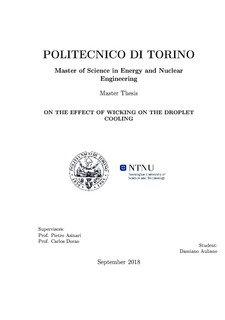| dc.description.abstract | Several thermal management applications operating at low temperatures require the liquid to spread as much as fast as possible in order to improve the cooling performance. Due to the recent progresses in micro/nano technology, it is possible to control the wickability of a surface by texturing it with micro/nano-structures. However, still there is not a common method to characterize the wickabilty for super-hydrophilic surfaces. In order to assess the effect of wickability on the droplet cooling, a proper wicking method has been implemented and validated, and surfaces coated with nanowires with different wickability have been fabricated and characterized. In this work, it has been shown that controlling the wickability of the surface allows to tune the heat transfer performance. The tallest nanowire surface( h = 25.27 ± 0.08 µm ) resulted in the highest wicking coe cient( w = 0.888 ± 0.076 mm/s0.5) and in the best cooling performance. With respect to the plain Si, nanowires with the highest wicking performance showed a decrease in the evaporation time of 82 %, 76 % and 68 % at respectively 51 °C, 69 °C and 92 °C. Moreover, increasing the surface temperature, reduces the effect of the surface wickability on the cooling time. | nb_NO |
